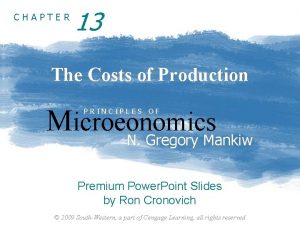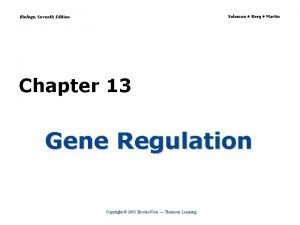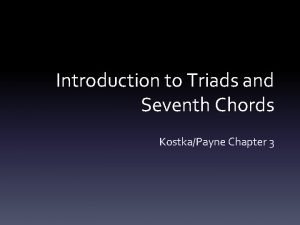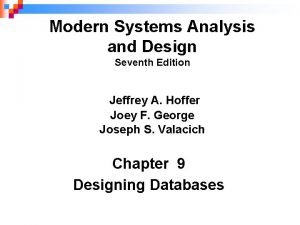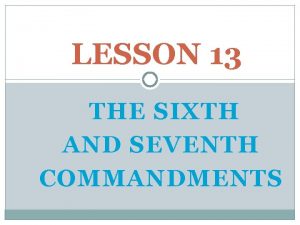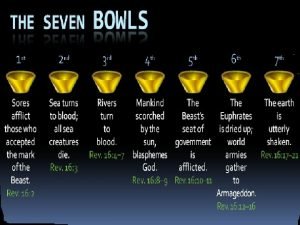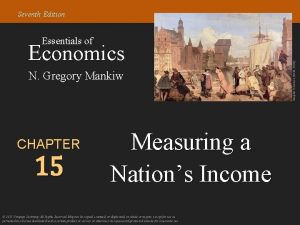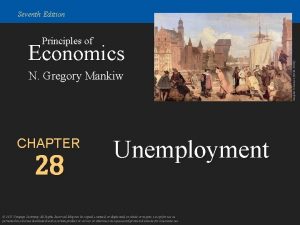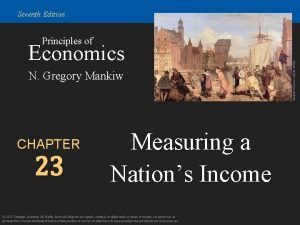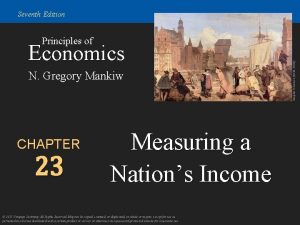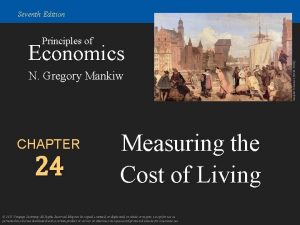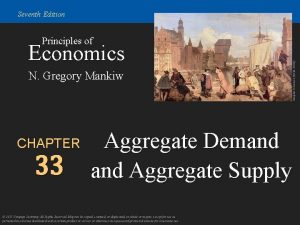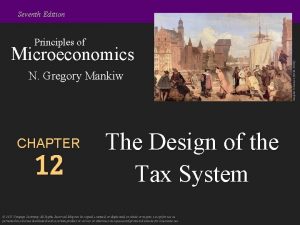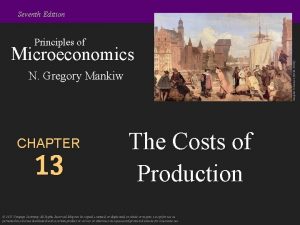Seventh Edition Economics N Gregory Mankiw CHAPTER 23













































- Slides: 45

Seventh Edition Economics N. Gregory Mankiw CHAPTER 23 Measuring a Nation’s Income © 2015 Cengage Learning. All Rights Reserved. May not be copied, scanned, or duplicated, in whole or in part, except for use as permitted in a license distributed with a certain product or service or otherwise on a password-protected website for classroom use. Wojciech Gerson (1831 -1901) Principles of

In this chapter, look for the answers to these questions • What is Gross Domestic Product (GDP)? • How is GDP related to a nation’s total income and spending? • What are the components of GDP? • How is GDP corrected for inflation? • Does GDP measure society’s well-being? © 2015 Cengage Learning. All Rights Reserved. May not be copied, scanned, or duplicated, in whole or in part, except for use as permitted in a license distributed with a certain product or service or otherwise on a password-protected website for classroom use.

Micro vs. Macro § Microeconomics: The study of how individual households and firms make decisions, interact with one another in markets. § Macroeconomics: The study of the economy as a whole. © 2015 Cengage Learning. All Rights Reserved. May not be copied, scanned, or duplicated, in whole or in part, except for use as permitted in a license distributed with a certain product or service or otherwise on a password-protected website for classroom use.

Income and Expenditure § Gross Domestic Product (GDP) measures total income of everyone in the economy. § GDP also measures total expenditure on the economy’s output of g&s. For the economy as a whole, income equals expenditure because every dollar a buyer spends is a dollar of income for the seller. © 2015 Cengage Learning. All Rights Reserved. May not be copied, scanned, or duplicated, in whole or in part, except for use as permitted in a license distributed with a certain product or service or otherwise on a password-protected website for classroom use.

The Circular-Flow Diagram § a simple depiction of the macroeconomy § illustrates GDP as spending, revenue, factor payments, and income § Preliminaries: § Factors of production are inputs like labor, land, capital, and natural resources. § Factor payments are payments to the factors of production (e. g. , wages, rent). © 2015 Cengage Learning. All Rights Reserved. May not be copied, scanned, or duplicated, in whole or in part, except for use as permitted in a license distributed with a certain product or service or otherwise on a password-protected website for classroom use.

The Circular-Flow Diagram Households: § own the factors of production, sell/rent them to firms for income § buy and consume goods & services Firms Households Firms: § buy/hire factors of production, use them to produce goods and services § sell goods & services © 2015 Cengage Learning. All Rights Reserved. May not be copied, scanned, or duplicated, in whole or in part, except for use as permitted in a license distributed with a certain product or service or otherwise on a password-protected website for classroom use. 5

The Circular-Flow Diagram Revenue (=GDP) G&S sold Markets for Goods & Services Firms Factors of production Wages, rent, profit (=GDP) Spending (=GDP) G&S bought Households Markets for Factors of Production © 2015 Cengage Learning. All Rights Reserved. May not be copied, scanned, or duplicated, in whole or in part, except for use as permitted in a license distributed with a certain product or service or otherwise on a password-protected website for classroom use. Labor, land, capital Income (=GDP) 6

What This Diagram Omits § The government § collects taxes, buys g&s § The financial system § matches savers’ supply of funds with borrowers’ demand for loans § The foreign sector § trades g&s, financial assets, and currencies with the country’s residents © 2015 Cengage Learning. All Rights Reserved. May not be copied, scanned, or duplicated, in whole or in part, except for use as permitted in a license distributed with a certain product or service or otherwise on a password-protected website for classroom use.

Gross Domestic Product (GDP) Is… …the market value of all final goods & services produced within a country in a given period of time. Goods are valued at their market prices, so: § All goods measured in the same units (e. g. , dollars in the U. S. ) § Things that don’t have a market value are excluded, e. g. , housework you do for yourself. © 2015 Cengage Learning. All Rights Reserved. May not be copied, scanned, or duplicated, in whole or in part, except for use as permitted in a license distributed with a certain product or service or otherwise on a password-protected website for classroom use. 8

Gross Domestic Product (GDP) Is… …the market value of all final goods & services produced within a country in a given period of time. Final goods: intended for the end user Intermediate goods: used as components or ingredients in the production of other goods GDP only includes final goods—they already embody the value of the intermediate goods used in their production. © 2015 Cengage Learning. All Rights Reserved. May not be copied, scanned, or duplicated, in whole or in part, except for use as permitted in a license distributed with a certain product or service or otherwise on a password-protected website for classroom use. 9

Gross Domestic Product (GDP) Is… …the market value of all final goods & services produced within a country in a given period of time. GDP includes tangible goods (like DVDs, mountain bikes, beer) and intangible services (dry cleaning, concerts, cell phone service). © 2015 Cengage Learning. All Rights Reserved. May not be copied, scanned, or duplicated, in whole or in part, except for use as permitted in a license distributed with a certain product or service or otherwise on a password-protected website for classroom use. 10

Gross Domestic Product (GDP) Is… …the market value of all final goods & services produced within a country in a given period of time. GDP includes currently produced goods, not goods produced in the past. © 2015 Cengage Learning. All Rights Reserved. May not be copied, scanned, or duplicated, in whole or in part, except for use as permitted in a license distributed with a certain product or service or otherwise on a password-protected website for classroom use. 11

Gross Domestic Product (GDP) Is… …the market value of all final goods & services produced within a country in a given period of time. GDP measures the value of production that occurs within a country’s borders, whether done by its own citizens or by foreigners located there. © 2015 Cengage Learning. All Rights Reserved. May not be copied, scanned, or duplicated, in whole or in part, except for use as permitted in a license distributed with a certain product or service or otherwise on a password-protected website for classroom use. 12

Gross Domestic Product (GDP) Is… …the market value of all final goods & services produced within a country in a given period of time. Usually a year or a quarter (3 months) © 2015 Cengage Learning. All Rights Reserved. May not be copied, scanned, or duplicated, in whole or in part, except for use as permitted in a license distributed with a certain product or service or otherwise on a password-protected website for classroom use. 13

The Components of GDP § Recall: GDP is total spending. § Four components: § Consumption (C) § Investment (I) § Government Purchases (G) § Net Exports (NX) § These components add up to GDP (denoted Y): Y = C + I + G + NX © 2015 Cengage Learning. All Rights Reserved. May not be copied, scanned, or duplicated, in whole or in part, except for use as permitted in a license distributed with a certain product or service or otherwise on a password-protected website for classroom use. 14

Consumption (C) § is total spending by households on g&s. § Note on housing costs: § For renters, consumption includes rent payments. § For homeowners, consumption includes the imputed rental value of the house, but not the purchase price or mortgage payments. © 2015 Cengage Learning. All Rights Reserved. May not be copied, scanned, or duplicated, in whole or in part, except for use as permitted in a license distributed with a certain product or service or otherwise on a password-protected website for classroom use.

Investment (I) § is total spending on goods that will be used in the future to produce more goods. § includes spending on § capital equipment (e. g. , machines, tools) § structures (factories, office buildings, houses) § inventories (goods produced but not yet sold) Note: “Investment” does not mean the purchase of financial assets like stocks and bonds. © 2015 Cengage Learning. All Rights Reserved. May not be copied, scanned, or duplicated, in whole or in part, except for use as permitted in a license distributed with a certain product or service or otherwise on a password-protected website for classroom use.

Government Purchases (G) § is all spending on the g&s purchased by govt at the federal, state, and local levels. § G excludes transfer payments, such as Social Security or unemployment insurance benefits. They are not purchases of g&s. © 2015 Cengage Learning. All Rights Reserved. May not be copied, scanned, or duplicated, in whole or in part, except for use as permitted in a license distributed with a certain product or service or otherwise on a password-protected website for classroom use.

Net Exports (NX) § NX = exports – imports § Exports represent foreign spending on the economy’s g&s. § Imports are the portions of C, I, and G that are spent on g&s produced abroad. § Adding up all the components of GDP gives: Y = C + I + G + NX © 2015 Cengage Learning. All Rights Reserved. May not be copied, scanned, or duplicated, in whole or in part, except for use as permitted in a license distributed with a certain product or service or otherwise on a password-protected website for classroom use.

U. S. GDP and Its Components, 2013 billions % of GDP per capita Y $16, 912 100. 0 $53, 350 C 11, 537 68. 2 36, 394 I 2, 738 16. 2 8, 637 G 3, 137 18. 5 9, 895 NX – 500 – 2. 9 – 1, 577 © 2015 Cengage Learning. All Rights Reserved. May not be copied, scanned, or duplicated, in whole or in part, except for use as permitted in a license distributed with a certain product or service or otherwise on a password-protected website for classroom use. 19

ACTIVE LEARNING 1 GDP and its components In each of the following cases, determine how much GDP and each of its components is affected (if at all). A. Debbie spends $300 to buy her husband dinner at the finest restaurant in Boston. B. Sarah spends $1200 on a new laptop to use in her publishing business. The laptop was built in China. C. Jane spends $800 on a computer to use in her editing business. She got last year’s model on sale for a great price from a local manufacturer. D. General Motors builds $500 million worth of cars, but consumers only buy $470 million worth of them. © 2015 Cengage Learning. All Rights Reserved. May not be copied, scanned, or duplicated, in whole or in part, except for use as permitted in a license distributed with a certain product or service or otherwise on a password-protected website for classroom use.

ACTIVE LEARNING Answers 1 A. Debbie spends $300 to buy her husband dinner at the finest restaurant in Boston. Consumption and GDP rise by $300. B. Sarah spends $1200 on a new laptop to use in her publishing business. The laptop was built in China. Investment rises by $1200, net exports fall by $1200, GDP is unchanged. © 2015 Cengage Learning. All Rights Reserved. May not be copied, scanned, or duplicated, in whole or in part, except for use as permitted in a license distributed with a certain product or service or otherwise on a password-protected website for classroom use.

ACTIVE LEARNING Answers 1 C. Jane spends $800 on a computer to use in her editing business. She got last year’s model on sale for a great price from a local manufacturer. Current GDP and investment do not change, because the computer was built last year. D. General Motors builds $500 million worth of cars, but consumers only buy $470 million of them. Consumption rises by $470 million, inventory investment rises by $30 million, and GDP rises by $500 million. © 2015 Cengage Learning. All Rights Reserved. May not be copied, scanned, or duplicated, in whole or in part, except for use as permitted in a license distributed with a certain product or service or otherwise on a password-protected website for classroom use.

Real versus Nominal GDP § Inflation can distort economic variables like GDP, so we have two versions of GDP: § Nominal GDP § values output using current prices § not corrected for inflation § Real GDP § values output using the prices of a base year § is corrected for inflation © 2015 Cengage Learning. All Rights Reserved. May not be copied, scanned, or duplicated, in whole or in part, except for use as permitted in a license distributed with a certain product or service or otherwise on a password-protected website for classroom use.

EXAMPLE: Pizza Latte year P Q 2011 $10 400 $2. 00 1000 2012 $11 500 $2. 50 1100 2013 $12 600 $3. 00 1200 Compute nominal GDP in each year: 2011: $10 x 400 + $2 x 1000 = $6, 000 2012: $11 x 500 + $2. 50 x 1100 = $8, 250 2013: $12 x 600 + $3 x 1200 © 2015 Cengage Learning. All Rights Reserved. May not be copied, scanned, or duplicated, in whole or in part, except for use as permitted in a license distributed with a certain product or service or otherwise on a password-protected website for classroom use. = $10, 800 Increase: 37. 5% 30. 9% 24

EXAMPLE: Pizza Latte year P Q 2011 $10 400 $2. 00 1000 2012 $11 500 $2. 50 1100 2013 $12 600 $3. 00 1200 Compute real GDP in each year, using 2011 as the base year: 2011: $10 x 400 + $2 x 1000 = $6, 000 2012: $10 x 500 + $2 x 1100 = $7, 200 2013: $10 x 600 + $2 x 1200 = $8, 400 © 2015 Cengage Learning. All Rights Reserved. May not be copied, scanned, or duplicated, in whole or in part, except for use as permitted in a license distributed with a certain product or service or otherwise on a password-protected website for classroom use. Increase: 20. 0% 16. 7% 25

EXAMPLE: year Nominal GDP Real GDP 2011 $6000 2012 $8250 $7200 2013 $10, 800 $8400 In each year, § nominal GDP is measured using the (then) current prices. § real GDP is measured using constant prices from the base year (2011 in this example). © 2015 Cengage Learning. All Rights Reserved. May not be copied, scanned, or duplicated, in whole or in part, except for use as permitted in a license distributed with a certain product or service or otherwise on a password-protected website for classroom use. 26

EXAMPLE: year Nominal GDP 2011 $6000 2012 $8250 2013 $10, 800 Real GDP 37. 5% 30. 9% $6000 $7200 $8400 20. 0% 16. 7% § The change in nominal GDP reflects both prices and quantities. § The change in real GDP is the amount that GDP would change if prices were constant (i. e. , if zero inflation). Hence, real GDP is corrected for inflation. © 2015 Cengage Learning. All Rights Reserved. May not be copied, scanned, or duplicated, in whole or in part, except for use as permitted in a license distributed with a certain product or service or otherwise on a password-protected website for classroom use. 27

Nominal and Real GDP in the U. S. , 1965– 2013 $18 000 $16 000 billions $14 000 $12 000 Real GDP $10 000 (base year 2009) $8 000 $6 000 $4 000 Nominal GDP $2 000 $0 1965 1970 1975 1980 1985 1990 1995 2000 2005 2010

The GDP Deflator § The GDP deflator is a measure of the overall level of prices. § Definition: nominal GDP deflator = 100 x real GDP § One way to measure the economy’s inflation rate is to compute the percentage increase in the GDP deflator from one year to the next. © 2015 Cengage Learning. All Rights Reserved. May not be copied, scanned, or duplicated, in whole or in part, except for use as permitted in a license distributed with a certain product or service or otherwise on a password-protected website for classroom use.

EXAMPLE: year Nominal GDP Real GDP Deflator 2011 $6000 100. 0 2012 $8250 $7200 114. 6 2013 $10, 800 $8400 128. 6 14. 6% 12. 2% Compute the GDP deflator in each year: 2011: 100 x (6000/6000) = 100. 0 2012: 100 x (8250/7200) = 114. 6 2013: 100 x (10, 800/8400) = 128. 6 © 2015 Cengage Learning. All Rights Reserved. May not be copied, scanned, or duplicated, in whole or in part, except for use as permitted in a license distributed with a certain product or service or otherwise on a password-protected website for classroom use. 30

ACTIVE LEARNING Computing GDP 2 2011 (base yr) P Good A Good B $30 $100 Q 2012 P 900 $31 192 $102 2013 Q P Q 1000 200 $36 $100 1050 205 Use the above data to solve these problems: A. Compute nominal GDP in 2011. B. Compute real GDP in 2012. C. Compute the GDP deflator in 2013. © 2015 Cengage Learning. All Rights Reserved. May not be copied, scanned, or duplicated, in whole or in part, except for use as permitted in a license distributed with a certain product or service or otherwise on a password-protected website for classroom use.

ACTIVE LEARNING Answers 2 2011 (base yr) P Good A Good B $30 $100 Q 2012 P 900 $31 192 $102 2013 Q P Q 1000 200 $36 $100 1050 205 A. Compute nominal GDP in 2011. $30 x 900 + $100 x 192 = $46, 200 B. Compute real GDP in 2012. $30 x 1000 + $100 x 200 = $50, 000 © 2015 Cengage Learning. All Rights Reserved. May not be copied, scanned, or duplicated, in whole or in part, except for use as permitted in a license distributed with a certain product or service or otherwise on a password-protected website for classroom use.

ACTIVE LEARNING Answers 2 2011 (base yr) P Good A Good B Q $30 $100 2012 P 900 $31 192 $102 2013 Q P Q 1000 200 $36 $100 1050 205 C. Compute the GDP deflator in 2013. Nom GDP = $36 x 1050 + $100 x 205 = $58, 300 Real GDP = $30 x 1050 + $100 x 205 = $52, 000 GDP deflator = 100 x (Nom GDP)/(Real GDP) = 100 x ($58, 300)/($52, 000) = 112. 1 © 2015 Cengage Learning. All Rights Reserved. May not be copied, scanned, or duplicated, in whole or in part, except for use as permitted in a license distributed with a certain product or service or otherwise on a password-protected website for classroom use.

GDP and Economic Well-Being § Real GDP per capita is the main indicator of the average person’s standard of living. § But GDP is not a perfect measure of well-being. § Robert Kennedy issued a very eloquent yet harsh criticism of GDP: © 2015 Cengage Learning. All Rights Reserved. May not be copied, scanned, or duplicated, in whole or in part, except for use as permitted in a license distributed with a certain product or service or otherwise on a password-protected website for classroom use.

Gross Domestic Product… “… does not allow for the health of our children, the quality of their education, or the joy of their play. It does not include the beauty of our poetry or the strength of our marriages, the intelligence of our public debate or the integrity of our public officials. It measures neither our courage, nor our wisdom, nor our devotion to our country. It measures everything, in short, except that which makes life worthwhile, and it can tell us everything about America except why we are proud that we are Americans. ” - Senator Robert Kennedy, 1968

GDP Does Not Value: § the quality of the environment § leisure time § non-market activity, such as the child care a parent provides at home § an equitable distribution of income © 2015 Cengage Learning. All Rights Reserved. May not be copied, scanned, or duplicated, in whole or in part, except for use as permitted in a license distributed with a certain product or service or otherwise on a password-protected website for classroom use.

Then Why Do We Care About GDP? § Having a large GDP enables a country to afford better schools, a cleaner environment, health care, etc. § Many indicators of the quality of life are positively correlated with GDP. For example… © 2015 Cengage Learning. All Rights Reserved. May not be copied, scanned, or duplicated, in whole or in part, except for use as permitted in a license distributed with a certain product or service or otherwise on a password-protected website for classroom use.

GDP and Life Expectancy in 12 countries Life expectancy (years) 90 Bangladesh China 80 Japan U. S. Mexico Brazil 70 Germany Russia Indonesia India 60 Pakistan 50 Nigeria 40 $0 $10 000 $20 000 $30 000 $40 000 Real GDP person $50 000 38

GDP and Average Schooling in 12 countries 14 Average years of school Germany Japan 12 10 China U. S. Russia Mexico 8 Brazil Indonesia 6 4 India 2 $0 $10 000 $20 000 $30 000 $40 000 Real GDP person $50 000 39

GDP and Water Quality in 12 countries Satisfaction with water quality (% of population) 100% Germany Indonesia Bangladesh 90% Japan Brazil 80% U. S. China 70% Mexico India 60% Pakistan 50% Russia Nigeria 40% $0 $10 000 $20 000 $30 000 $40 000 Real GDP person $50 000 40

Summary • Gross Domestic Product (GDP) measures a country’s total income and expenditure. • The four spending components of GDP include: Consumption, Investment, Government Purchases, and Net Exports. • Nominal GDP is measured using current prices. Real GDP is measured using the prices of a constant base year and is corrected for inflation. • GDP is the main indicator of a country’s economic well-being, even though it is not perfect. © 2015 Cengage Learning. All Rights Reserved. May not be copied, scanned, or duplicated, in whole or in part, except for use as permitted in a license distributed with a certain product or service or otherwise on a password-protected website for classroom use.

Summary • People face tradeoffs. • The cost of any action is measured in terms of foregone opportunities. • Rational people make decisions by comparing marginal costs and marginal benefits. • People respond to incentives. © 2015 Cengage Learning. All Rights Reserved. May not be copied, scanned, or duplicated, in whole or in part, except for use as permitted in a license distributed with a certain product or service or otherwise on a password-protected website for classroom use.

Summary • People face tradeoffs. • The cost of any action is measured in terms of foregone opportunities. • Rational people make decisions by comparing marginal costs and marginal benefits. • People respond to incentives. © 2015 Cengage Learning. All Rights Reserved. May not be copied, scanned, or duplicated, in whole or in part, except for use as permitted in a license distributed with a certain product or service or otherwise on a password-protected website for classroom use.

Summary • People face tradeoffs. • The cost of any action is measured in terms of foregone opportunities. • Rational people make decisions by comparing marginal costs and marginal benefits. • People respond to incentives. © 2015 Cengage Learning. All Rights Reserved. May not be copied, scanned, or duplicated, in whole or in part, except for use as permitted in a license distributed with a certain product or service or otherwise on a password-protected website for classroom use.
 Principles of economics mankiw 9th edition ppt
Principles of economics mankiw 9th edition ppt Principles of economics mankiw 9th edition ppt
Principles of economics mankiw 9th edition ppt Macroeconomics ninth edition
Macroeconomics ninth edition Mankiw chapter 26 solutions
Mankiw chapter 26 solutions Monopoly
Monopoly Active learning 3 calculating costs
Active learning 3 calculating costs Endomysium
Endomysium Chords rule in dbms
Chords rule in dbms Principles of business information systems
Principles of business information systems Molecular biology of the cell seventh edition
Molecular biology of the cell seventh edition Biology seventh edition
Biology seventh edition Site:slidetodoc.com
Site:slidetodoc.com Intermediate macroeconomics mankiw
Intermediate macroeconomics mankiw Mankiw slides
Mankiw slides Mankiw
Mankiw Figured bass seventh chords
Figured bass seventh chords Using mis 10th edition
Using mis 10th edition Zulily case study
Zulily case study Principle of economics third edition
Principle of economics third edition Modern labor economics 12th edition solution
Modern labor economics 12th edition solution Vertical economics
Vertical economics Macroeconomics michael parkin 13th edition
Macroeconomics michael parkin 13th edition Managerial economics 12th edition mark hirschey
Managerial economics 12th edition mark hirschey Parkin economics 12th edition
Parkin economics 12th edition Principles of economics sixth edition
Principles of economics sixth edition Modern labor economics 12th edition
Modern labor economics 12th edition Maastricht university school of business and economics
Maastricht university school of business and economics Mathematical economics vs non mathematical economics
Mathematical economics vs non mathematical economics The devil from seventh grade
The devil from seventh grade The seventh man characters
The seventh man characters You shall not steal. this commandment is number
You shall not steal. this commandment is number Dante circles of hell
Dante circles of hell Seventh-day adventist leadership structure
Seventh-day adventist leadership structure Brave seventh grade viking warrior
Brave seventh grade viking warrior Masahiro murakami
Masahiro murakami Article 9 of the creed
Article 9 of the creed Mother and daughter gary soto summary
Mother and daughter gary soto summary Seventh normal form
Seventh normal form Hamlet's 7th soliloquy analysis
Hamlet's 7th soliloquy analysis Seventh day baptist
Seventh day baptist The fifth, sixth, seventh, and eighth amendments protect *
The fifth, sixth, seventh, and eighth amendments protect * Seventh day adventist church
Seventh day adventist church Sixth and seventh commandments
Sixth and seventh commandments At the seventh sprint review the stakeholders
At the seventh sprint review the stakeholders Seventh grade by gary soto character traits
Seventh grade by gary soto character traits What's the 7 trumpets
What's the 7 trumpets





